Rubric Best Practices, Examples, and Templates
A rubric is a scoring tool that identifies the different criteria relevant to an assignment, assessment, or learning outcome and states the possible levels of achievement in a specific, clear, and objective way. Use rubrics to assess project-based student work including essays, group projects, creative endeavors, and oral presentations.
Rubrics can help instructors communicate expectations to students and assess student work fairly, consistently and efficiently. Rubrics can provide students with informative feedback on their strengths and weaknesses so that they can reflect on their performance and work on areas that need improvement.

How to Get Started
Best practices, moodle how-to guides.
- Workshop Recording (Fall 2022)
- Workshop Registration
Step 1: Analyze the assignment
The first step in the rubric creation process is to analyze the assignment or assessment for which you are creating a rubric. To do this, consider the following questions:
- What is the purpose of the assignment and your feedback? What do you want students to demonstrate through the completion of this assignment (i.e. what are the learning objectives measured by it)? Is it a summative assessment, or will students use the feedback to create an improved product?
- Does the assignment break down into different or smaller tasks? Are these tasks equally important as the main assignment?
- What would an “excellent” assignment look like? An “acceptable” assignment? One that still needs major work?
- How detailed do you want the feedback you give students to be? Do you want/need to give them a grade?
Step 2: Decide what kind of rubric you will use
Types of rubrics: holistic, analytic/descriptive, single-point
Holistic Rubric. A holistic rubric includes all the criteria (such as clarity, organization, mechanics, etc.) to be considered together and included in a single evaluation. With a holistic rubric, the rater or grader assigns a single score based on an overall judgment of the student’s work, using descriptions of each performance level to assign the score.
Advantages of holistic rubrics:
- Can p lace an emphasis on what learners can demonstrate rather than what they cannot
- Save grader time by minimizing the number of evaluations to be made for each student
- Can be used consistently across raters, provided they have all been trained
Disadvantages of holistic rubrics:
- Provide less specific feedback than analytic/descriptive rubrics
- Can be difficult to choose a score when a student’s work is at varying levels across the criteria
- Any weighting of c riteria cannot be indicated in the rubric
Analytic/Descriptive Rubric . An analytic or descriptive rubric often takes the form of a table with the criteria listed in the left column and with levels of performance listed across the top row. Each cell contains a description of what the specified criterion looks like at a given level of performance. Each of the criteria is scored individually.
Advantages of analytic rubrics:
- Provide detailed feedback on areas of strength or weakness
- Each criterion can be weighted to reflect its relative importance
Disadvantages of analytic rubrics:
- More time-consuming to create and use than a holistic rubric
- May not be used consistently across raters unless the cells are well defined
- May result in giving less personalized feedback
Single-Point Rubric . A single-point rubric is breaks down the components of an assignment into different criteria, but instead of describing different levels of performance, only the “proficient” level is described. Feedback space is provided for instructors to give individualized comments to help students improve and/or show where they excelled beyond the proficiency descriptors.
Advantages of single-point rubrics:
- Easier to create than an analytic/descriptive rubric
- Perhaps more likely that students will read the descriptors
- Areas of concern and excellence are open-ended
- May removes a focus on the grade/points
- May increase student creativity in project-based assignments
Disadvantage of analytic rubrics: Requires more work for instructors writing feedback
Step 3 (Optional): Look for templates and examples.
You might Google, “Rubric for persuasive essay at the college level” and see if there are any publicly available examples to start from. Ask your colleagues if they have used a rubric for a similar assignment. Some examples are also available at the end of this article. These rubrics can be a great starting point for you, but consider steps 3, 4, and 5 below to ensure that the rubric matches your assignment description, learning objectives and expectations.
Step 4: Define the assignment criteria
Make a list of the knowledge and skills are you measuring with the assignment/assessment Refer to your stated learning objectives, the assignment instructions, past examples of student work, etc. for help.
Helpful strategies for defining grading criteria:
- Collaborate with co-instructors, teaching assistants, and other colleagues
- Brainstorm and discuss with students
- Can they be observed and measured?
- Are they important and essential?
- Are they distinct from other criteria?
- Are they phrased in precise, unambiguous language?
- Revise the criteria as needed
- Consider whether some are more important than others, and how you will weight them.
Step 5: Design the rating scale
Most ratings scales include between 3 and 5 levels. Consider the following questions when designing your rating scale:
- Given what students are able to demonstrate in this assignment/assessment, what are the possible levels of achievement?
- How many levels would you like to include (more levels means more detailed descriptions)
- Will you use numbers and/or descriptive labels for each level of performance? (for example 5, 4, 3, 2, 1 and/or Exceeds expectations, Accomplished, Proficient, Developing, Beginning, etc.)
- Don’t use too many columns, and recognize that some criteria can have more columns that others . The rubric needs to be comprehensible and organized. Pick the right amount of columns so that the criteria flow logically and naturally across levels.
Step 6: Write descriptions for each level of the rating scale
Artificial Intelligence tools like Chat GPT have proven to be useful tools for creating a rubric. You will want to engineer your prompt that you provide the AI assistant to ensure you get what you want. For example, you might provide the assignment description, the criteria you feel are important, and the number of levels of performance you want in your prompt. Use the results as a starting point, and adjust the descriptions as needed.
Building a rubric from scratch
For a single-point rubric , describe what would be considered “proficient,” i.e. B-level work, and provide that description. You might also include suggestions for students outside of the actual rubric about how they might surpass proficient-level work.
For analytic and holistic rubrics , c reate statements of expected performance at each level of the rubric.
- Consider what descriptor is appropriate for each criteria, e.g., presence vs absence, complete vs incomplete, many vs none, major vs minor, consistent vs inconsistent, always vs never. If you have an indicator described in one level, it will need to be described in each level.
- You might start with the top/exemplary level. What does it look like when a student has achieved excellence for each/every criterion? Then, look at the “bottom” level. What does it look like when a student has not achieved the learning goals in any way? Then, complete the in-between levels.
- For an analytic rubric , do this for each particular criterion of the rubric so that every cell in the table is filled. These descriptions help students understand your expectations and their performance in regard to those expectations.
Well-written descriptions:
- Describe observable and measurable behavior
- Use parallel language across the scale
- Indicate the degree to which the standards are met
Step 7: Create your rubric
Create your rubric in a table or spreadsheet in Word, Google Docs, Sheets, etc., and then transfer it by typing it into Moodle. You can also use online tools to create the rubric, but you will still have to type the criteria, indicators, levels, etc., into Moodle. Rubric creators: Rubistar , iRubric
Step 8: Pilot-test your rubric
Prior to implementing your rubric on a live course, obtain feedback from:
- Teacher assistants
Try out your new rubric on a sample of student work. After you pilot-test your rubric, analyze the results to consider its effectiveness and revise accordingly.
- Limit the rubric to a single page for reading and grading ease
- Use parallel language . Use similar language and syntax/wording from column to column. Make sure that the rubric can be easily read from left to right or vice versa.
- Use student-friendly language . Make sure the language is learning-level appropriate. If you use academic language or concepts, you will need to teach those concepts.
- Share and discuss the rubric with your students . Students should understand that the rubric is there to help them learn, reflect, and self-assess. If students use a rubric, they will understand the expectations and their relevance to learning.
- Consider scalability and reusability of rubrics. Create rubric templates that you can alter as needed for multiple assignments.
- Maximize the descriptiveness of your language. Avoid words like “good” and “excellent.” For example, instead of saying, “uses excellent sources,” you might describe what makes a resource excellent so that students will know. You might also consider reducing the reliance on quantity, such as a number of allowable misspelled words. Focus instead, for example, on how distracting any spelling errors are.
Example of an analytic rubric for a final paper
Example of a holistic rubric for a final paper, single-point rubric, more examples:.
- Single Point Rubric Template ( variation )
- Analytic Rubric Template make a copy to edit
- A Rubric for Rubrics
- Bank of Online Discussion Rubrics in different formats
- Mathematical Presentations Descriptive Rubric
- Math Proof Assessment Rubric
- Kansas State Sample Rubrics
- Design Single Point Rubric
Technology Tools: Rubrics in Moodle
- Moodle Docs: Rubrics
- Moodle Docs: Grading Guide (use for single-point rubrics)
Tools with rubrics (other than Moodle)
- Google Assignments
- Turnitin Assignments: Rubric or Grading Form
Other resources
- DePaul University (n.d.). Rubrics .
- Gonzalez, J. (2014). Know your terms: Holistic, Analytic, and Single-Point Rubrics . Cult of Pedagogy.
- Goodrich, H. (1996). Understanding rubrics . Teaching for Authentic Student Performance, 54 (4), 14-17. Retrieved from
- Miller, A. (2012). Tame the beast: tips for designing and using rubrics.
- Ragupathi, K., Lee, A. (2020). Beyond Fairness and Consistency in Grading: The Role of Rubrics in Higher Education. In: Sanger, C., Gleason, N. (eds) Diversity and Inclusion in Global Higher Education. Palgrave Macmillan, Singapore.
Essay Rubric: Basic Guidelines and Sample Template
11 December 2023
last updated
Lectures and tutors provide specific requirements for students to meet when writing essays. Basically, an essay rubric helps tutors to analyze the quality of articles written by students. In this case, useful rubrics make the analysis process simple for lecturers as they focus on specific concepts related to the writing process. Also, an essay rubric list and organize all of the criteria into one convenient paper. In other instances, students use an essay rubric to enhance their writing skills by examining various requirements. Then, different types of essay rubrics vary from one educational level to another. For example, Master’s and Ph.D. essay rubrics focus on examining complex thesis statements and other writing mechanics. However, high school essay rubrics examine basic writing concepts. In turn, a sample template of a high school rubric in this article can help students to evaluate their papers before submitting them to their teachers.
General Aspects of an Essay Rubric
An essay rubric refers to the way how teachers assess student’s composition writing skills and abilities. Basically, an essay rubric provides specific criteria to grade assignments. In this case, teachers use essay rubrics to save time when evaluating and grading various papers. Hence, learners must use an essay rubric effectively to achieve desired goals and grades.

General Assessment Table for an Essay Rubric
1. organization.
Excellent/8 points: The essay contains stiff topic sentences and a controlled organization.
Very Good/6 points: The essay contains a logical and appropriate organization. The writer uses clear topic sentences.
Average/4 points: The essay contains a logical and appropriate organization. The writer uses clear topic sentences.
Needs Improvement/2 points: The essay has an inconsistent organization.
Unacceptable/0 points: The essay shows the absence of a planned organization.
Grade: ___ .
Excellent/8 points: The essay shows the absence of a planned organization.
Very Good/6 points: The paper contains precise and varied sentence structures and word choices.
Average/4 points: The paper follows a limited but mostly correct sentence structure. There are different sentence structures and word choices.
Needs Improvement/2 points: The paper contains several awkward and unclear sentences. There are some problems with word choices.
Unacceptable/0 points: The writer does not contain apparent control over sentence structures and word choice.
Excellent/8 points: The content appears sophisticated and contains well-developed ideas.
Very Good/6 points: The essay content appears illustrative and balanced.
Average/4 points: The essay contains unbalanced content that requires more analysis.
Needs Improvement/2 points: The essay contains a lot of research information without analysis or commentary.
Unacceptable/0 points: The essay lacks relevant content and does not fit the thesis statement . Essay rubric rules are not followed.
Excellent/8 points: The essay contains a clearly stated and focused thesis statement.
Very Good/6 points: The written piece comprises a clearly stated argument. However, the focus would have been sharper.
Average/4 points: The thesis phrasing sounds simple and lacks complexity. The writer does not word the thesis correctly.
Needs Improvement/2 points: The thesis statement requires a clear objective and does not fit the theme in the content of the essay.
Unacceptable/0 points: The thesis is not evident in the introduction.
Excellent/8 points: The essay is clear and focused. The work holds the reader’s attention. Besides, the relevant details and quotes enrich the thesis statement.
Very Good/6 points: The essay is mostly focused and contains a few useful details and quotes.
Average/4 points: The writer begins the work by defining the topic. However, the development of ideas appears general.
Needs Improvement/2 points: The author fails to define the topic well, or the writer focuses on several issues.
Unacceptable/0 points: The essay lacks a clear sense of a purpose or thesis statement. Readers have to make suggestions based on sketchy or missing ideas to understand the intended meaning. Essay rubric requirements are missed.

6. Sentence Fluency
Excellent/8 points: The essay has a natural flow, rhythm, and cadence. The sentences are well built and have a wide-ranging and robust structure that enhances reading.
Very Good/6 points: The ideas mostly flow and motivate a compelling reading.
Average/4 points: The text hums along with a balanced beat but tends to be more businesslike than musical. Besides, the flow of ideas tends to become more mechanical than fluid.
Needs Improvement/2 points: The essay appears irregular and hard to read.
Unacceptable/0 points: Readers have to go through the essay several times to give this paper a fair interpretive reading.
7. Conventions
Excellent/8 points: The student demonstrates proper use of standard writing conventions, like spelling, punctuation, capitalization, grammar, usage, and paragraphing. The student uses protocols in a way that improves the readability of the essay.
Very Good/6 points: The student demonstrates proper writing conventions and uses them correctly. One can read the essay with ease, and errors are rare. Few touch-ups can make the composition ready for publishing.
Average/4 points: The writer shows reasonable control over a short range of standard writing rules. The writer handles all the conventions and enhances readability. The errors in the essay tend to distract and impair legibility.
Needs Improvement/2 points: The writer makes an effort to use various conventions, including spelling, punctuation, capitalization, grammar usage, and paragraphing. The essay contains multiple errors.
Unacceptable/0 points: The author makes repetitive errors in spelling, punctuation, capitalization, grammar, usage, and paragraphing. Some mistakes distract readers and make it hard to understand the concepts. Essay rubric rules are not covered.
8. Presentation
Excellent/8 points: The form and presentation of the text enhance the readability of the essay and the flow of ideas.
Very Good/6 points: The format has few mistakes and is easy to read.
Average/4 points: The writer’s message is understandable in this format.
Needs Improvement/2 points: The writer’s message is only comprehensible infrequently, and the paper appears disorganized.
Unacceptable/0 points: Readers receive a distorted message due to difficulties connecting to the presentation of the text.
Final Grade: ___ .
Grading Scheme for an Essay Rubric:
- A+ = 60+ points
- A = 55-59 points
- A- = 50-54 points
- B+ = 45-49 points
- B = 40-44 points
- B- = 35-39 points
- C+ = 30-34 points
- C = 25-29 points
- C- = 20-24 points
- D = 10-19 points
- F = less than 9 points
Basic Differences in Education Levels and Essay Rubrics
The quality of essays changes at different education levels. For instance, college students must write miscellaneous papers when compared to high school learners. In this case, an essay rubric will change for these different education levels. For example, university and college essays should have a debatable thesis statement with varying points of view. However, high school essays should have simple phrases as thesis statements. Then, other requirements in an essay rubric will be more straightforward for high school students. For master’s and Ph.D. essays, the criteria presented in an essay rubric should focus on examining the paper’s complexity. In turn, compositions for these two categories should have thesis statements that demonstrate a detailed analysis of defined topics that advance knowledge in a specific area of study.
Summing Up on an Essay Rubric
Essay rubrics help teachers, instructors, professors, and tutors to analyze the quality of essays written by students. Basically, an essay rubric makes the analysis process simple for lecturers. Essay rubrics list and organize all of the criteria into one convenient paper. In other instances, students use the essay rubrics to improve their writing skills. However, they vary from one educational level to the other. Master’s and Ph.D. essay rubrics focus on examining complex thesis statements and other writing mechanics. However, high school essay rubrics examine basic writing concepts. The following are some of the tips that one must consider when preparing a rubric.
- contain all writing mechanics that relates to essay writing;
- cover different requirements and their relevant grades;
- follow clear and understandable statements.
To Learn More, Read Relevant Articles
How to cite a newspaper article in apa 7 with examples, how to write a "who am i" essay: free tips with examples.

Center for Excellence in Teaching
Home > Resources > Academic essay rubric
Academic essay rubric
This is a grading rubric an instructor uses to assess students’ work on this type of assignment. It is a sample rubric that needs to be edited to reflect the specifics of a particular assignment.
Download this file
Download this file [63.33 KB]
Back to Resources Page
- LentaDesign.com
7 Free Rubric Templates in Google Docs
When it comes to evaluating and assessing various tasks, rubrics are invaluable tools. They provide a structured way to grade or evaluate assignments, projects, or performances. Google Docs is a widely used platform for document creation and collaboration, and it's a convenient choice for creating and sharing rubrics. In this article, we'll explore the top seven rubric templates that you can use in Google Docs to streamline your assessment process.
Table of Contents
- Analytic Rubric
- Holistic Rubric
- Scoring Rubric
- Checklist Rubric
- Behavioral Rubric
- Group Project Rubric
- Writing Rubric
How to Get Started with Google Docs Rubric Template
Getting started with our template is quick and easy. Follow these simple steps:
Access the Template : Click on link below each template image to access the template in Google Docs.
Make a Copy : To use the template, click on button "Use Template" in the top right corner." This action will create a duplicate of the template in your Google Drive. Note: You must be logged in your Google account.
Customize : Open the copied template in Google Docs and customize it to your liking. Add your organization's logo, adjust fonts and colors, and make any necessary changes to the structure to match your meeting requirements.
Save and Share : Once you've customized the template, save it in your Google Drive. You can easily share it with your team members, allowing everyone to access and use the template for their meetings.
Analytic Rubric Google Docs Template
Analytic rubrics break down assessments into specific criteria and levels of achievement. They are well-suited for providing detailed feedback on various aspects of a task or assignment, making them a versatile choice for educators and evaluators.
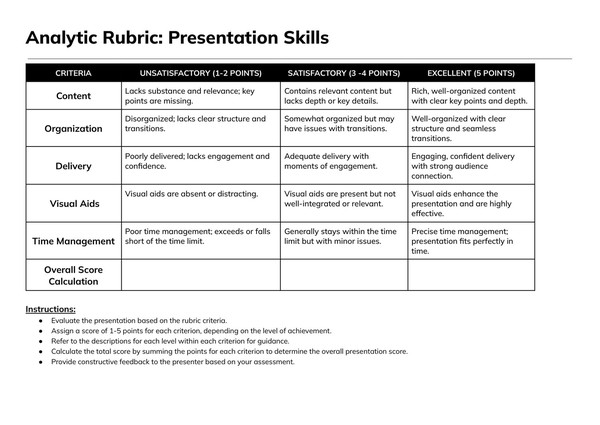
Download Analytic Rubric Google Docs Template
Holistic Rubric Google Docs Template
Holistic rubrics, on the other hand, provide a broad, overall assessment of a task. They are ideal for situations where you want to evaluate the entire work as a whole. Holistic rubrics are often used in scenarios where a detailed breakdown isn't necessary.
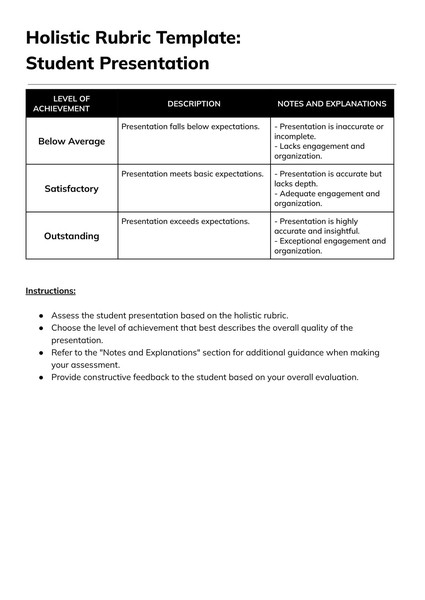
Download Holistic Rubric Google Docs Template
Scoring Rubric Google Docs Template
Scoring rubrics are perhaps the most common type used in education. They assign numerical scores to assignments, making them easy to calculate and understand. These rubrics are great for assessments where you want to quantify performance.
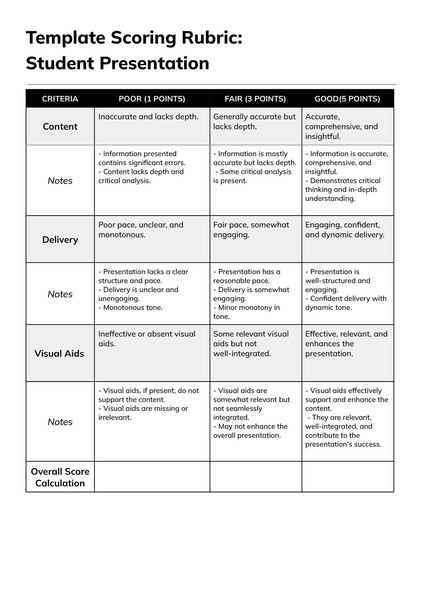
Download Scoring Rubric Google Docs Template
Checklist Rubric Google Docs Template
Checklist rubrics are simple and straightforward. They consist of a list of criteria or tasks that need to be completed, and each criterion is binary—either it's checked (completed) or unchecked (not completed). Checklist rubrics are handy for ensuring tasks are completed systematically.
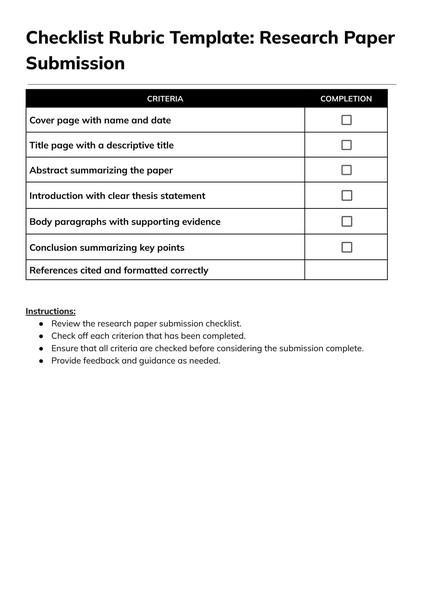
Download Checklist Rubric Google Docs Template
Behavioral Rubric Google Docs Template
Behavioral rubrics are often used in professional settings to evaluate behaviors and competencies. They assess specific behaviors or actions expected in a job role, making them valuable tools for employee evaluations and development.
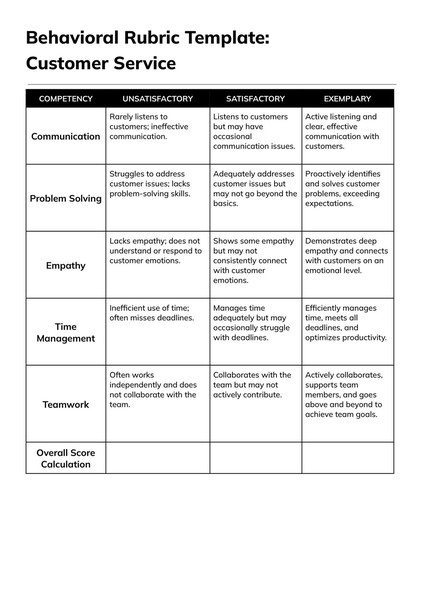
Download Behavioral Rubric Google Docs Template
Group Project Rubric Google Docs Template
Group projects are common in educational and professional settings. Group project rubrics assess teamwork, collaboration, and individual contributions within a group. They are essential for ensuring fair evaluations in group assignments.
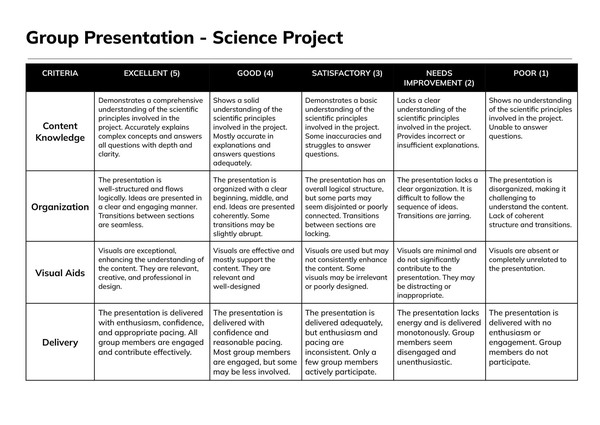
Download Group Project Rubric Google Docs Template
Writing Rubric Google Docs Template
Writing rubrics are particularly crucial for evaluating written assignments, essays, and reports. They focus on aspects such as clarity, organization, grammar, and content. Writing rubrics help provide structured feedback to improve writing skills.
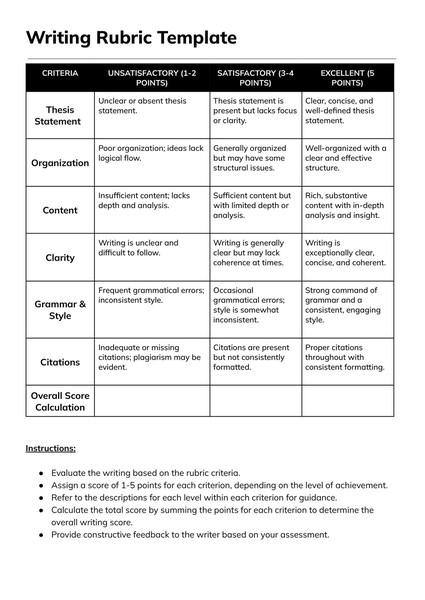
Download Writing Rubric Google Docs Template
Incorporating these rubric templates into Google Docs can streamline your assessment process and help you provide clear and consistent feedback to students or colleagues. To use them effectively, simply copy and paste the template into your Google Docs document, customize it to your specific needs, and start assessing with ease.
Rubrics not only make the grading process more efficient but also offer a transparent and fair way to evaluate performance. Whether you're an educator, manager, or team leader, these rubric templates can help you maintain consistency and provide valuable feedback in various assessment scenarios.
So, which rubric template suits your assessment needs best? Let's dive into each type in more detail to help you make an informed choice.
1. Can I modify these rubric templates to suit my specific needs?
- Absolutely! Rubric templates in Google Docs are highly customizable. You can adjust criteria, descriptions, and scoring to align with your assessment goals.
2. What is the main difference between scoring and analytic rubrics?
- The key difference lies in how they evaluate tasks. Scoring rubrics provide an overall score, often numeric, for an entire assignment, while analytic rubrics break down the assessment into specific criteria and levels of achievement.
3. When should I use a scoring rubric, and when should I opt for an analytic rubric?
- Use a scoring rubric when you want to assign a single numeric score to an assignment and focus on the overall quality.
- Choose an analytic rubric when you need to evaluate and provide detailed feedback on various aspects or criteria within an assignment.
4. Can I use both scoring and analytic rubrics for the same assessment?
- Yes, you can use both rubric types if it suits your assessment goals. Start with an analytic rubric to evaluate specific criteria, and then use a scoring rubric to summarize the overall score.
5. How do I decide which rubric type is best for a particular assignment?
- Consider the nature of the assignment: Analytic rubrics are suitable for complex assignments with multiple criteria while scoring rubrics work well for straightforward assessments.
- Think about the level of detail required: If you need to provide in-depth feedback on various aspects, choose an analytic rubric.
6. Can I create my own custom rubric that combines elements of both scoring and analytic rubrics?
- Yes, you can create a hybrid rubric that combines aspects of both types to suit your specific assessment needs. Tailor it to the criteria and goals of your assignment.
- Google Docs
- Interior design
- Mission style
- Small Apartment

IMAGES
VIDEO
COMMENTS
Essay Rubric Directions: Your essay will be graded based on this rubric. Consequently, use this rubric as a guide when writing your essay and check it again before you submit your essay. Traits 4 3 2 1 Focus & Details There is one clear, well-focused topic. Main ideas are clear and are well supported by detailed and accurate information.
Rubric Best Practices, Examples, and Templates. A rubric is a scoring tool that identifies the different criteria relevant to an assignment, assessment, or learning outcome and states the possible levels of achievement in a specific, clear, and objective way. Use rubrics to assess project-based student work including essays, group projects ...
An essay rubric refers to the way how teachers assess student's composition writing skills and abilities. Basically, an essay rubric provides specific criteria to grade assignments. In this case, teachers use essay rubrics to save time when evaluating and grading various papers.
Essay contains an intro, main body, and conclusion. The introduction lays out the main argument but gives the reader little idea of what to expect in the essay. The conclusion nicely summarizes the main argument and evidence, but does not move beyond what has already been presented in the paper. Essay contains an intro, main body, and conclusion.
Logical, compelling progression of ideas in essay;clear structure which enhances and showcases the central idea or theme and moves the reader through the text. Organization flows so smoothly the reader hardly thinks about it. Effective, mature, graceful transitions exist throughout the essay.
While spelling and grammar are not specifically mentioned in the rubric, they are graded on the assumption that everyone is attempting to write college level papers. Matters of form, style and either the MLA Handbook or the Chicago Handbook of Style governs citation of source material.
Grading rubrics can be of great benefit to both you and your students. For you, a rubric saves time and decreases subjectivity. Specific criteria are explicitly stated, facilitating the grading process and increasing your objectivity. For students, the use of grading rubrics helps them to meet or exceed expectations, to view the grading process ...
concludes effectively, provocatively, and creatively. demonstrates an understanding of basic terminology. In regard to syntax and mechanics, the essay is free of errors in usage, punctuation, and sentence structure. provides a list of works cited following the appropriate bibliographic conventions. demonstrates competence.
New Word Persuasive Essay Rubric. Weak/Missing. Introduction effectively engages the reader, presents new word, previews case for selection; conclusion sums up argument and effectively reiterates case for word selection. Introduction attempts to engage the reader, presents the new word, and may preview the case for selection; conclusion sums up ...
Academic essay rubric. This is a grading rubric an instructor uses to assess students' work on this type of assignment. It is a sample rubric that needs to be edited to reflect the specifics of a particular assignment. Download this file. Page. /. 3. Download this file [63.33 KB] Back to Resources Page.
Please note each essay has a different prompt and will be different to review. See the electronic rubric for more information. Criteria Not Acceptable (1) Somewhat ... electronic rubric for specific essay prompts) •Essay did not address or answer the given prompt • Reader didn't see any relatability to the prompt or the subject of the
Rubrics are tools for communicating grading criteria and assessing student progress. Rubrics take a variety of forms, from grids to checklists, and measure a range of writing tasks, from conceptual design to sentence-level considerations. As with any assessment tool, a rubric's effectiveness is entirely dependent upon its design and its ...
Written by the Brandeis University Writing Program and revised by Ryan Wepler YALE COLLEGE ENGL 114: Grading Rubric The A Essay makes an interesting, complex—even surprising—argument and is thoroughly well-executed.While an A essay is the result of serious effort, the grade is based on the essay's content and presentation.
Five-Paragraph Essay Writing Rubric. Thesis statement/topic idea sentence is clear, correctly placed, and restated in the closing sentence. Your three supporting ideas are briefly mentioned. Thesis statement/topic idea sentence is either unclear or incorrectly placed, and it's restated in the closing sentence.
Generic Rubric for Practice. The essay is unclear with no organization. The main points of the essay are ambiguous. Writing has minimal organization and a basic thesis statement. Writing follows a logical organization, but sometimes drifts from the thesis. Writing is clear, logical, and very organized around a developed thesis.
Sentences lack structure and appear incomplete or rambling. Grammar, Spelling, Capitalization, & Punctuation. There are no errors in grammar, spelling, capitalization, or punctuation. Rubric is attached to essay. Essay is completed on time. There are some errors; however, these errors do not distract the reader. Rubric is attached to essay.
Section 1. Evaluation of Thinking (continued) Directions: For each of the three criteria (content and focus; analysis and critical thinking; logic and flow) select 10, 8, 6, 4, or 2 from the five possible scores (representing strong, proficient, satisfactory, weak, or unacceptable, respectively). Section 2. Evaluation of Communicating Ideas.
Narrative Essay Rubric (100 points) Name: 10-9 Precise and consistent demonstration of the writing skills learned in class. Fulfills all of the requirements outlined in the essay rubric. Expresses ability to make inferences and applications to world outside of classroom environment. 8 Correct demonstration of the writing skills learned in class ...
A grading rubric template includes the criteria you will use to assess a specific task. This can be anything from writing a paper to giving an oral presentation, and more. Rubrics permit teachers to convey their expectations to students. You can also use them to track the progress of a student from the start of the task to the end of it.
Lacks thorough information or support. Mechanics, Essay Style. Grammatically sound. Smooth and understandable Follows assignment rules. Includes thesis and supporting paragraphs. Written in essay format. Few grammatical errors Some areas may lack clarity. Follows assignment rules. Includes thesis and paragraphs might lack some specifics.
Follow these simple steps: Access the Template: Click on link below each template image to access the template in Google Docs. Make a Copy: To use the template, click on button "Use Template" in the top right corner." This action will create a duplicate of the template in your Google Drive. Note: You must be logged in your Google account.
Some of the language used in this rubric has been adapted from the SBAC and PAARC rubrics. 4 - Exceeds 3 - Proficient 2 - Approaching 1 - Beginning Understanding Demonstrates a deep understanding of content Shows a solid understanding of content Demonstrates a limited understanding of content Does not demonstrate understanding, or shows a